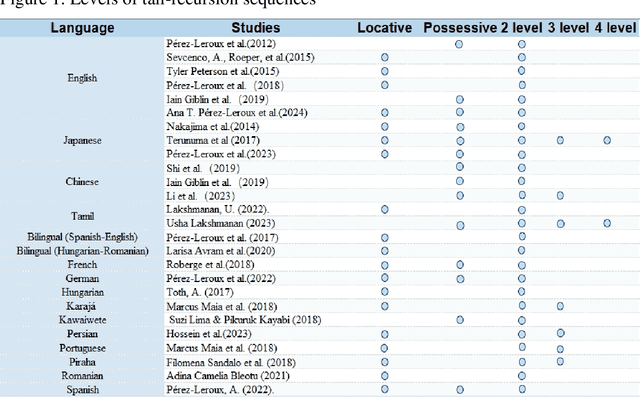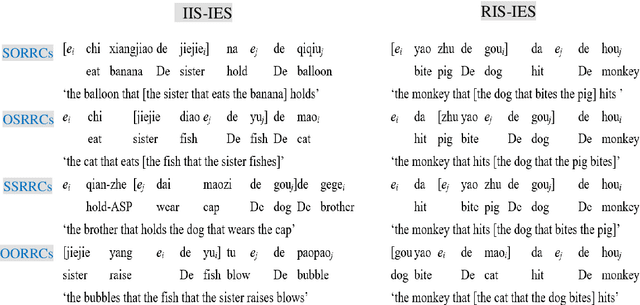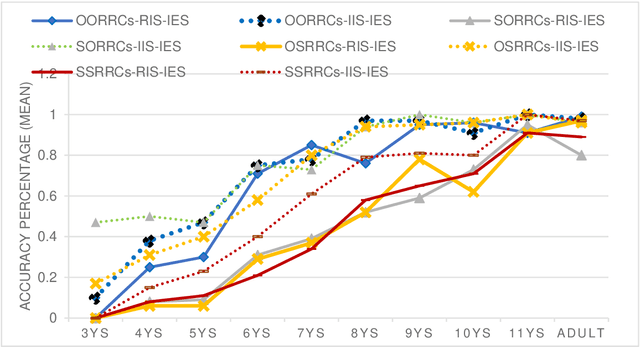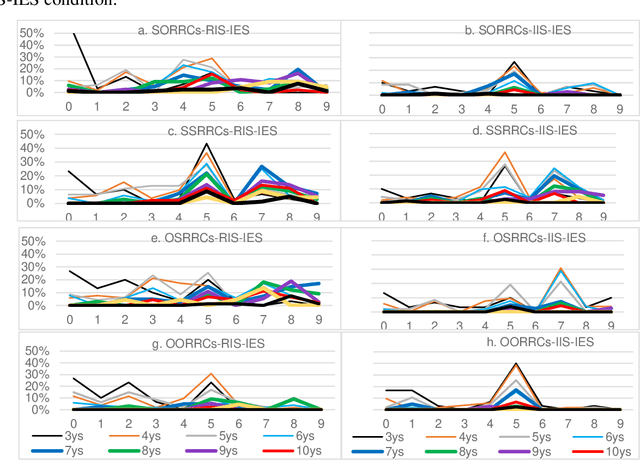Caimei Yang
Children's Acquisition of Tail-recursion Sequences: A Review of Locative Recursion and Possessive Recursion as Examples
Dec 28, 2024
Abstract:Recursion is the nature of human natural language. Since Chomsky proposed generative grammar, many scholars have studied recursion either theoretically or empirically. However, by observing children's acquisition of tail recursion sequences, we can verify the nativism of language supported by universal grammar and reveal the cognitive mechanism of human brain. To date, our understanding of children's acquisition path of recursion and influencing factors still remain controversial. This systematic review summarizes the research of tail recursive sequence by taking possessive recursion and locative recursion as examples, focusing on the experimental methods, acquisition paths, and influencing factors of tail recursive sequence. The current behavioural experiments reveal that, the debate about children's performance revolves around: 1) Gradual acquisition or synchronous acquisition. 2) symmetry or asymmetry between the acquisition of locative recursion sequences and possessive recursion sequences. We presume that children can acquire recursion quickly in a short period of time thanks to the language acquisition device, though there are also scholars who believe that a third factor also plays a role.
Acquisition of Recursive Possessives and Recursive Locatives in Mandarin
Dec 21, 2024Abstract:As recursion has been underlying any linguistic work for the last 60 years, the acquisition of recursive structures by children during language learning has become a focal point of inquiry. This study delves into the developmental trajectory of Mandarin-speaking children's acquisition of recursive possessives and locatives, assessing the impact of structural diversity on language acquisition. The research contrasts the comprehension of two-level recursive structures among children aged 3 to 7 years, employing answering question while seeing a picture task to elicit responses. The findings indicate that children do not attain adult-like proficiency in two-level recursion until the age of 6, and there exists a notable asymmetry in the acquisition of recursive possessives versus locatives. These results underscore the primacy of structural complexity and cognitive factors in the acquisition process, enhancing our comprehension of the cognitive foundations of language development and the pivotal role of recursion in child language acquisition.
The syntax-semantics interface in a child's path: A study of 3- to 11-year-olds' elicited production of Mandarin recursive relative clauses
Jun 06, 2024



Abstract:There have been apparently conflicting claims over the syntax-semantics relationship in child acquisition. However, few of them have assessed the child's path toward the acquisition of recursive relative clauses (RRCs). The authors of the current paper did experiments to investigate 3- to 11-year-olds' most-structured elicited production of eight Mandarin RRCs in a 4 (syntactic types)*2 (semantic conditions) design. The four syntactic types were RRCs with a subject-gapped RC embedded in an object-gapped RC (SORRCs), RRCs with an object-gapped RC embedded in another object-gapped RC (OORRCs), RRCs with an object-gapped RC embedded in a subject-gapped RC (OSRRCs), and RRCs with a subject-gapped RC embedded in another subject-gapped RC (SSRRCs). Each syntactic type was put in two conditions differing in internal semantics: irreversible internal semantics (IIS) and reversible internal semantics (RIS). For example, "the balloon that [the girl that _ eats the banana] holds _" is SORRCs in the IIS condition; "the monkey that [the dog that _ bites the pig] hits_" is SORRCs in the RIS condition. For each target, the participants were provided with a speech-visual stimulus constructing a condition of irreversible external semantics (IES). The results showed that SSRRCs, OSRRCs and SORRCs in the IIS-IES condition were produced two years earlier than their counterparts in the RIS-IES condition. Thus, a 2-stage development path is proposed: the language acquisition device starts with the interface between (irreversible) syntax and IIS, and ends with the interface between syntax and IES, both abiding by the syntax-semantic interface principle.
Grammaticality illusion or ambiguous interpretation? Event-related potentials reveal the nature of the missing-NP effect in Mandarin centre-embedded structures
Feb 17, 2024Abstract:In several languages, omitting a verb phrase (VP) in double centre-embedded structures creates a grammaticality illusion. Similar illusion also exhibited in Mandarin missing-NP double centre-embedded structures. However, there is no consensus on its very nature. Instead of treating it as grammaticality illusion, we argue that ambiguous interpretations of verbs can best account for this phenomenon in Mandarin. To further support this hypothesis, we conducted two electroencephalography (EEG) experiments on quasi double centre-embedded structures whose complexity is reduced by placing the self-embedding relative clauses into the sentence's subject position. Experiment 1 showed that similar phenomenon even exhibited in this structure, evidenced by an absence of P600 effect and a presence of N400 effect. In Experiment 2, providing semantic cues to reduce ambiguity dispelled this illusion, as evidenced by a P600 effect. We interpret the results under garden-path theory and propose that word-order difference may account for this cross-linguistic variation.
 Add to Chrome
Add to Chrome Add to Firefox
Add to Firefox Add to Edge
Add to Edge